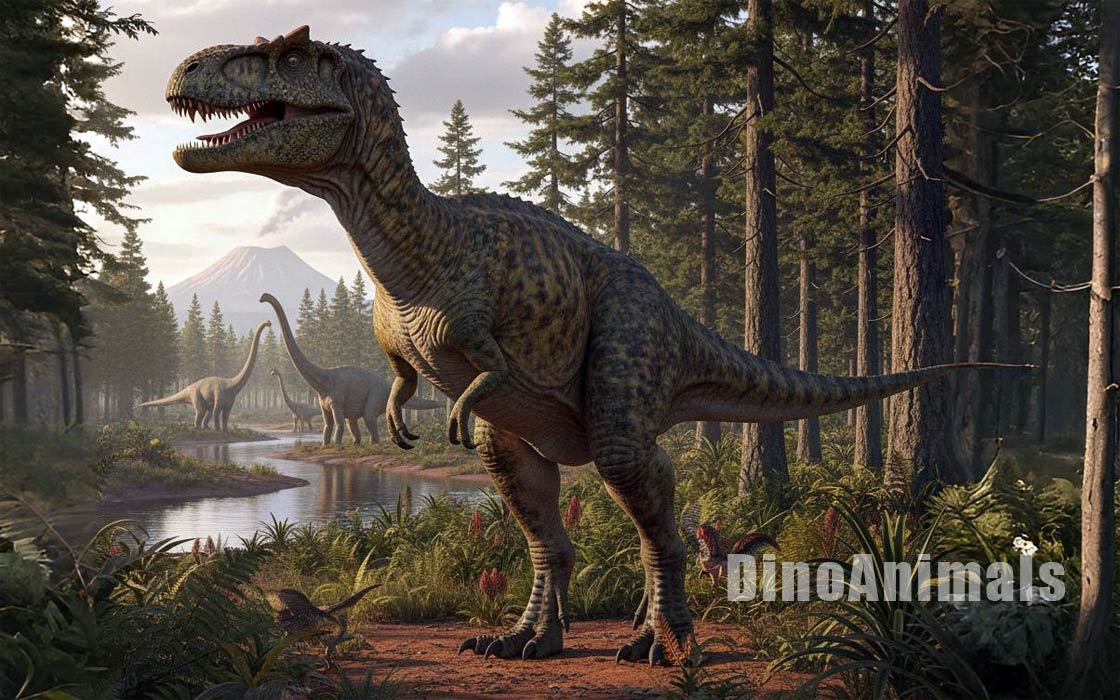Every month, 100,000 readers use the Dinosaur Database, but we receive no support from you. Developing and updating the database requires a lot of work. If you want it to remain open and be updated, please support us via the "Buy us a coffee" button available on every page or via the Support page.
Dinosaur: Allosaurus fragilis

| Length*: | 10 m | 32.8 ft |
| Weight*: | 3.5 t | 7,716 lb |
| Speed: | 34 km/h | 21 mph |
*The largest known specimen
Period
Epoch: Late Jurassic
Stage: Kimmeridgian-Tithonian
Years: 155–145 Ma
Details
Status: valid
Author: Marsh
Year: 1877
Distribution
Area: North America
Country: USA
Region: Colorado, Montana, New Mexico, Oklahoma, South Dakota, Utah, Wyoming
Formation: Morrison
Description
Allosaurus fragilis
Allosaurus fragilis was one of the most common and formidable carnivorous dinosaurs of the Late Jurassic period, around 155 to 145 million years ago. Its name, meaning “different lizard,” refers to the unique structure of its vertebrae, which set it apart from other dinosaurs discovered at the time. Fossils of Allosaurus have been found primarily in North America, particularly in the Morrison Formation, a rich fossil site that has provided valuable insights into Late Jurassic ecosystems.
Physical Characteristics
Allosaurus fragilis was a medium to large theropod dinosaur, typically reaching lengths of about 8.5 up to 10 meters (28 to 33 feet) and standing around 3.2 meters (10.5 feet) tall at the hips. It weighed between 1.5 to 2.2 metric tons, with larger individuals possibly reaching up to 4 metric tons. Allosaurus had a large skull, approximately 0.8 to 1 meter (2.6 to 3.3 feet) long, filled with sharp, serrated teeth designed for slicing through flesh. It possessed a pair of distinctive short, bony crests above its eyes, which may have been used for display or species recognition. Its forelimbs were relatively short but strong, with three-fingered hands equipped with large, curved claws ideal for grasping prey.
Diet and Feeding Habits
Allosaurus fragilis was a carnivore that likely preyed on a variety of herbivorous dinosaurs, including stegosaurs and juvenile sauropods. Its skull and jaw structure suggest that it was capable of delivering powerful bites, but recent studies propose that Allosaurus may have used its upper jaw like a hatchet, slashing downwards to inflict deep wounds. Its flexible neck and sharp claws further aided in restraining and tearing apart prey. Evidence from tooth marks found on bones and healed injuries suggests that Allosaurus was also a scavenger, feeding opportunistically on carcasses.
Habitat and Distribution
Allosaurus lived in a variety of environments within what is now North America, particularly in regions that were semi-arid with seasonal wet and dry periods. The Morrison Formation, where many Allosaurus fossils have been found, was characterized by floodplains, river channels, and fern prairies that supported a diverse range of plant and animal life. Fossils of Allosaurus fragilis have been discovered across several U.S. states, including Colorado, Utah, and Wyoming, indicating a broad geographic range.
Behavior and Social Structure
There is evidence to suggest that Allosaurus might have been a social predator, hunting in packs or at least in loose groups. This theory is supported by findings of multiple Allosaurus specimens at a single site, suggesting group behavior, potentially to take down larger prey or protect kills from scavengers. However, some scientists argue that such groupings could also be the result of individuals being attracted to a common food source. Injuries and bite marks on Allosaurus fossils indicate intraspecific combat, possibly related to disputes over territory or mates.
Discovery and Research
Allosaurus fragilis was first discovered in 1877 by Othniel Charles Marsh, a prominent American paleontologist, during the “Bone Wars,” a period of intense fossil discovery and rivalry. The species was named based on remains found in the Morrison Formation of Colorado. Since then, over 60 specimens have been found, making it one of the best-studied theropods. The discovery of the Cleveland-Lloyd Dinosaur Quarry in Utah, which contains a large concentration of Allosaurus bones, has provided a wealth of information about its anatomy, growth patterns, and behavior.
Significance and Interesting Facts
Allosaurus is significant for being one of the most common and well-represented large theropods of the Late Jurassic, providing a critical window into the life of predatory dinosaurs during this period. It was one of the top predators of its time, occupying a niche similar to that of the later Tyrannosaurus rex. The discovery of numerous fossils, including well-preserved skulls and skeletons, has allowed paleontologists to study its biology in detail, making it one of the best-understood large carnivorous dinosaurs. Recent research has even suggested that Allosaurus may have had a highly efficient, avian-like respiratory system, providing it with the stamina needed for active predation.
Locations
Sources
Material: Many skeletons also with skulls (juvenile and adult).
References:
• Madsen, J.H.Jr. (1993) [1976]. Allosaurus fragilis: A Revised Osteology.
• Paul, G.S. (1988). "Genus Allosaurus".
• Predatory Dinosaurs of the World.Glut, Donald F. (1997). "Allosaurus". Dinosaurs: The Encyclopedia.




